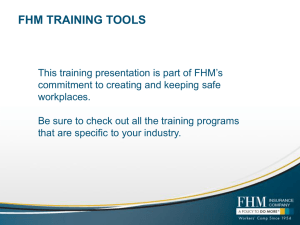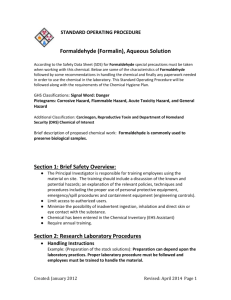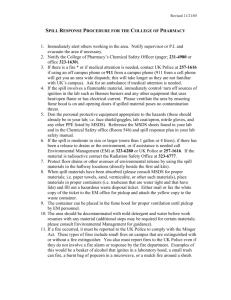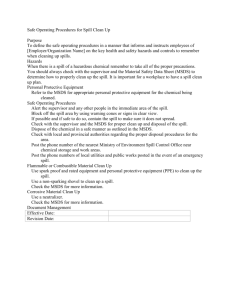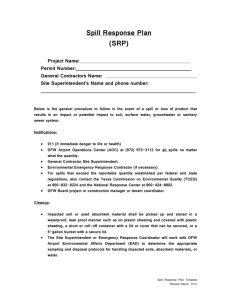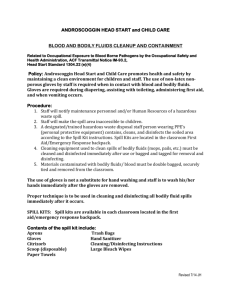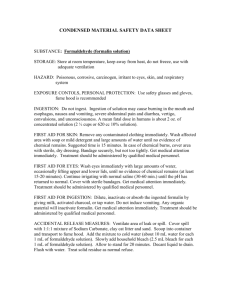Formaldehyde - Environmental Health & Safety
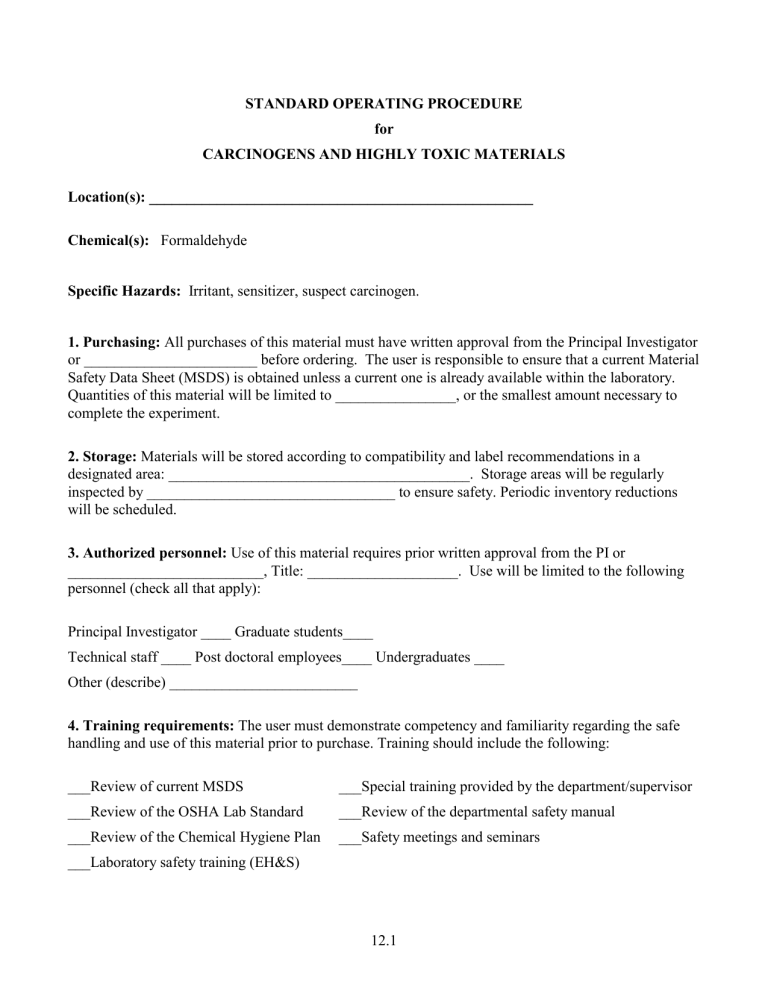
STANDARD OPERATING PROCEDURE for
CARCINOGENS AND HIGHLY TOXIC MATERIALS
Location(s): ___________________________________________________
Chemical(s): Formaldehyde
Specific Hazards: Irritant, sensitizer, suspect carcinogen.
1. Purchasing: All purchases of this material must have written approval from the Principal Investigator or _______________________ before ordering. The user is responsible to ensure that a current Material
Safety Data Sheet (MSDS) is obtained unless a current one is already available within the laboratory.
Quantities of this material will be limited to ________________, or the smallest amount necessary to complete the experiment.
2. Storage: Materials will be stored according to compatibility and label recommendations in a designated area: ________________________________________. Storage areas will be regularly inspected by _________________________________ to ensure safety. Periodic inventory reductions will be scheduled.
3. Authorized personnel: Use of this material requires prior written approval from the PI or
__________________________, Title: ____________________. Use will be limited to the following personnel (check all that apply):
Principal Investigator ____ Graduate students____
Technical staff ____ Post doctoral employees____ Undergraduates ____
Other (describe) _________________________
4. Training requirements: The user must demonstrate competency and familiarity regarding the safe handling and use of this material prior to purchase. Training should include the following:
___Review of current MSDS
___Review of the OSHA Lab Standard
___Special training provided by the department/supervisor
___Review of the departmental safety manual
___Review of the Chemical Hygiene Plan ___Safety meetings and seminars
___Laboratory safety training (EH&S)
12.1
5. Use location: Materials shall be used only in the following designated areas in room ______. Check all that apply: demarcated area in lab (describe)________________________________________ fume hood ___X__ glove box _____ other (describe) _______________________
6. Personal protective equipment: All personnel are required to wear the following personal protective equipment whenever handling this material (check all that apply):
Safety goggles _____ Chemical safety goggles ___X__ Face shield __X___
Gloves (type/use):
Incidental Contact: double glove with nitrile gloves (4 mil) or use 8 mil or thicker nitrile gloves
Extended Contact: nuse 8 mil or thicker nitrile gloves
Lab coat _____X____ Rubber apron ____X____ Tyvek clothing ____________
Respirator (type) ______________ Other (describe) ___________________
7. Waste disposal: The authorized person using this material is responsible for the safe collection, preparation and proper disposal of waste unless otherwise stated below. Waste shall be disposed of as soon as possible and in accordance with all laboratory and University procedures.
Specific instructions: Up to 100 ml. at a time of a 10% or less solution may be rinsed down the drain with plenty of water.
Contact EH&S for information on the disposal of large quantities of formaldehyde.
8. Decontamination: Specific instructions: Wash hands thoroughly after each use. Remove contaminated clothes and place them in well a ventilated space - the formaldehyde will off-gas.
Contaminated clothes may be washed for faster decontamination.
9. Exposures: Emergency procedures to be followed (from MSDS): The perception of formaldehyde by odor and eye irritation becomes less sensitive with time. This can lead to overexposure if worker is relying on formaldehyde's warning properties to alert him. Persons with a history of skin or eye disorders; liver, kidney or respiratory disorders may be at increased risk from exposure.
Skin contact
Symptoms: Causes redness, pain. first aid: Immediately flush skin with water for at least 15 min. Seek medical attention if necessary.
Eye contact symptoms: Causes redness, pain, blurred vision, blindness. first aid: Immediately flush skin or eyes with water for at least 15 min. Seek medical attention if necessary.
12.2
Inhalation
Symptoms: May cause sore throat, coughing and shortness of breath. Causes irritation of respiratory tract. A concentration of 20 ppm or greater is considered to be immediately dangerous to life or health.
First aid: Remove to fresh air immediately. If not breathing, give artificial respiration. Get medical attention immediately while performing emergency first aid.
Ingestion symptoms: Causes severe abdominal pain, violent vomiting. first aid: Induce vomiting immediately by giving two glasses of water, or milk if available, and sticking finger down throat. Seek medical attention.
10. Spills: Spill cleanup materials to be used, location of materials, PPE to be used, disposal of cleanup materials, etc. Please be as complete as possible:
Ventilate area. For small spills (up to 50 ml. of 37% material), soak up with spill absorbent material immediately. Store collected spill material in a zippered plastic bag or wide mouth plastic container with a tight-fitting lid for disposal by EHS.
For a large spill, ventilate the area of the spill and leave the room.
Do not attempt to clean up a large spill unless you have Cornell EH&S approved respiratory protection and training spill response.
11. Phone numbers:
Cornell Campus Police 911 (accidents, spills)
Environmental Health and Safety 5-8200
Gannett Health Center 5-5155
12. Other: Special precautions, incompatible/reactive materials, usable shelf life, etc. Please be as specific as possible:
Keep in tightly closed container. Prevent any physical damage to the container. Keep away from heat, sparks, and flame. Keep separate from oxidizing materials and alkalies. Reacts violently with nitrogen dioxide, perchloric acid/aniline mixtures and nitromethane. Protect from freezing; avoid low temperatures as nonhazardous polymerization may occur.
Prepared by: ________________________________
Date: _____________
Reviewed/Revised: _________________
A copy of the completed SOP must be filed with the Cornell Chemical Hygiene Officer at EH&S,
125 Humphreys Service Building.
12.3

